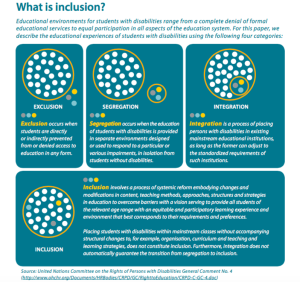By *Dr Robert Jackson and Catia Malaquias
Our “Tips for Teachers” series is a collection of short practical tips for teachers to improve the inclusiveness of their general education classrooms.
The 2017 school year is about to start and teachers in regular mainstream classrooms will be busy planning and preparing teaching materials, including differentiated curricula materials for students with disability allocated to their class. To assist, we have gathered together all our “Tips for Teachers” articles on this page, including some additional information.
Tips For Teachers Series:
Creating An Inclusive Class Culture – Practical Tips For Teachers (N.o1)
Supporting Peer Connection in the Inclusive Class – Practical Tips For Teachers (No.2)
Less Is More: The Education Assistant – Practical Tips For Teachers (No.3)
Other information
The General Comment No 4 (Right to Inclusive Education) by the the United Nations Committee on the Rights of Persons with Disabilities provides an important overview of what is meant by inclusive education and the human right of children with disability to access a quality inclusive education system under Article 24 of the United Nations Convention on the Rights of Persons with Disabilities to which Australia is a signatory. An understanding of the human rights principles that underlie access to and inclusion of students with disability in mainstream education is important to understanding how to support that right in everyday practice. You can read our summary of the General Comment No 4 here: UN Committee Clarifies Right to Inclusive Education.
For information on research into the benefits and practice of inclusive education see:
“Inclusion in Education: Towards Equality for Students with Disability“, Dr K. Cologon, Children and Young People With Disability Australia.
“A summary of the Evidence in Inclusive Education“, in depth review of research worldwide, by Dr. Thomas Hehir, Silvana and Christopher Pascucci Professor of Practice in Learning Differences at the Harvard Graduate School of Education and Abt Associates.
“Inclusion Works! Inclusive education, research and practice“, Xuan Bui, Carol Quirk, Selene Almazan, Michele Valenti.
“What is Inclusion?” As a graphic “snapshot”

(Source: A summary of the Evidence in Inclusive Education, see above).
*Dr Robert Jackson is an Associate Professor of Education at Curtin University in Western Australia, a registered Psychologist and a Director of Include. You can connect with Dr Jackson on Twitter @include108 or through include.com.au
*Catia Malaquias is a mother of three young children, a lawyer and the Founder of Starting With Julius. You can connect with Catia on Twitter @CatiaMalaquias or on Facebook.
[Cover photo © Sebastian Pichler]
Thank you for visiting our website. You can also keep up with our mission for #edinclusion by liking our Facebook page or following us on Twitter @StartingWJulius
